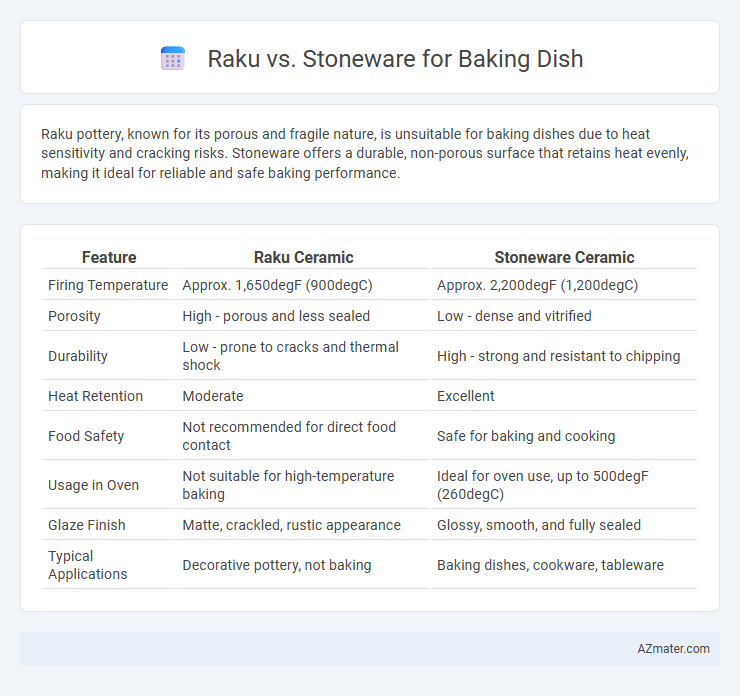Raku pottery, known for its porous and fragile nature, is unsuitable for baking dishes due to heat sensitivity and cracking risks. Stoneware offers a durable, non-porous surface that retains heat evenly, making it ideal for reliable and safe baking performance.
Table of Comparison
| Feature | Raku Ceramic | Stoneware Ceramic |
|---|---|---|
| Firing Temperature | Approx. 1,650degF (900degC) | Approx. 2,200degF (1,200degC) |
| Porosity | High - porous and less sealed | Low - dense and vitrified |
| Durability | Low - prone to cracks and thermal shock | High - strong and resistant to chipping |
| Heat Retention | Moderate | Excellent |
| Food Safety | Not recommended for direct food contact | Safe for baking and cooking |
| Usage in Oven | Not suitable for high-temperature baking | Ideal for oven use, up to 500degF (260degC) |
| Glaze Finish | Matte, crackled, rustic appearance | Glossy, smooth, and fully sealed |
| Typical Applications | Decorative pottery, not baking | Baking dishes, cookware, tableware |
Introduction to Raku and Stoneware Baking Dishes
Raku baking dishes are handcrafted using a unique Japanese pottery technique that involves rapid cooling and firing, resulting in distinctive crackled textures and enhanced thermal shock resistance. Stoneware baking dishes, made from dense, non-porous clay fired at high temperatures, offer durability, even heat distribution, and excellent moisture retention for consistent baking results. Both materials provide functional and aesthetic benefits, with raku emphasizing artistic appeal and stoneware prioritizing practical cooking performance.
Material Composition: Raku vs Stoneware
Raku baking dishes are crafted from porous clay fired at lower temperatures, resulting in a lightweight yet fragile material with unique crackle glaze patterns. Stoneware baking dishes are made from dense clay fired at high temperatures, producing a non-porous, durable, and heat-retentive surface ideal for even baking. The material composition of stoneware ensures better thermal shock resistance compared to the more delicate and decorative Raku pieces.
Heat Resistance and Baking Performance
Raku pottery, characterized by its porous structure and low firing temperature, offers limited heat resistance and is prone to cracking under direct oven heat, making it less suitable for baking dishes. Stoneware, fired at higher temperatures around 1,200degC to 1,300degC, provides excellent thermal shock resistance and retains heat evenly, ensuring reliable baking performance. The dense, non-porous nature of stoneware prevents moisture absorption, allowing it to withstand high oven temperatures without deteriorating or breaking.
Durability and Longevity Comparison
Raku pottery, known for its unique firing process, tends to be less durable and more prone to cracking under thermal shock compared to stoneware, which is fired at higher temperatures resulting in a dense, non-porous structure ideal for baking dishes. Stoneware's high firing temperature, typically around 1200degC to 1300degC, enhances its strength and makes it resistant to chipping, thermal expansion, and frequent oven use. For long-term durability and consistent performance in baking applications, stoneware is generally preferred over Raku due to its robustness and longevity.
Thermal Shock: Handling Sudden Temperature Changes
Raku baking dishes excel in handling sudden temperature changes due to their low thermal mass and rapid cooling properties, making them ideal for quick temperature shifts. Stoneware offers superior thermal stability with a slow, even heat distribution that minimizes the risk of cracking under thermal shock but requires gradual temperature changes. Choosing between Raku and Stoneware for baking depends on whether rapid cooling or consistent, steady heating better suits your cooking style.
Safety and Food Compatibility
Raku ceramics, traditionally used for decorative purposes, often feature porous surfaces and glazes that may contain lead or other toxins, making them less suitable and potentially unsafe for direct food contact or baking. Stoneware, fired at higher temperatures, is non-porous, durable, and typically free of harmful chemicals, ensuring safe use in ovens and compatibility with various foods. Choosing stoneware for baking dishes guarantees food safety, heat resistance, and longevity, whereas Raku requires caution due to potential contamination risks.
Aesthetic Appeal and Design Options
Raku baking dishes showcase a distinctive, artisanal aesthetic with crackled glazes and unpredictable patterns that enhance rustic and artistic kitchen decor. Stoneware offers a more uniform, earthy look with a variety of glaze colors and smooth finishes, appealing to traditional and modern design preferences. Both materials provide diverse design options, but Raku's unique firing process creates one-of-a-kind pieces, while stoneware allows for consistent, versatile styles.
Ease of Cleaning and Maintenance
Raku baking dishes are known for their porous surface, which can absorb oils and food residues, making them more challenging to clean and maintain compared to stoneware. Stoneware features a non-porous, glazed finish that resists stains and odors, allowing for effortless cleaning with standard dishwashing methods. Regular sealing and careful hand washing are essential for Raku to preserve its durability, while stoneware typically requires minimal maintenance and is often dishwasher safe.
Cost and Availability
Stoneware baking dishes typically offer greater affordability and wider availability compared to Raku pottery, making them a practical choice for everyday use. Raku dishes, handcrafted through a special firing process, tend to be more expensive and less accessible due to their artisanal nature and limited production. Consumers seeking cost-effective and readily obtainable baking options often prefer stoneware for its durability and consistent performance.
Which is Best for Baking: Raku or Stoneware?
Stoneware is typically best for baking dishes because of its excellent heat retention and even heat distribution, which ensures consistent cooking results. Raku, while prized for its unique artistic qualities and crackled glaze, is more porous and less durable under high-temperature baking conditions, making it less suitable for everyday oven use. Stoneware's non-porous, vitrified surface prevents absorption of moisture and odors, providing superior performance and longevity for baking needs.

Infographic: Raku vs Stoneware for Baking Dish
 azmater.com
azmater.com